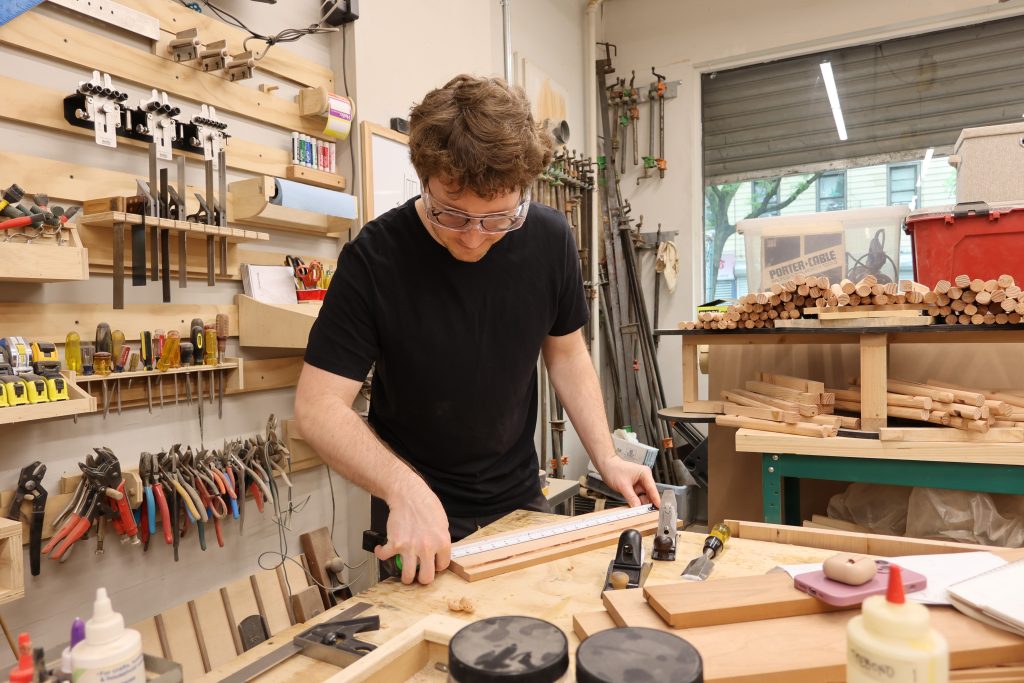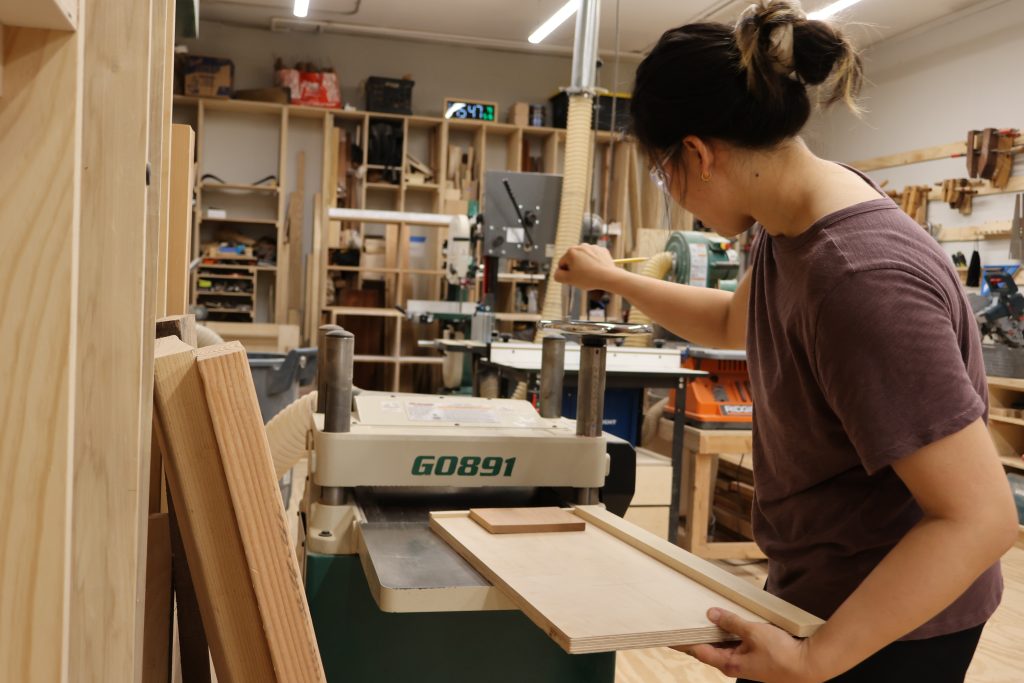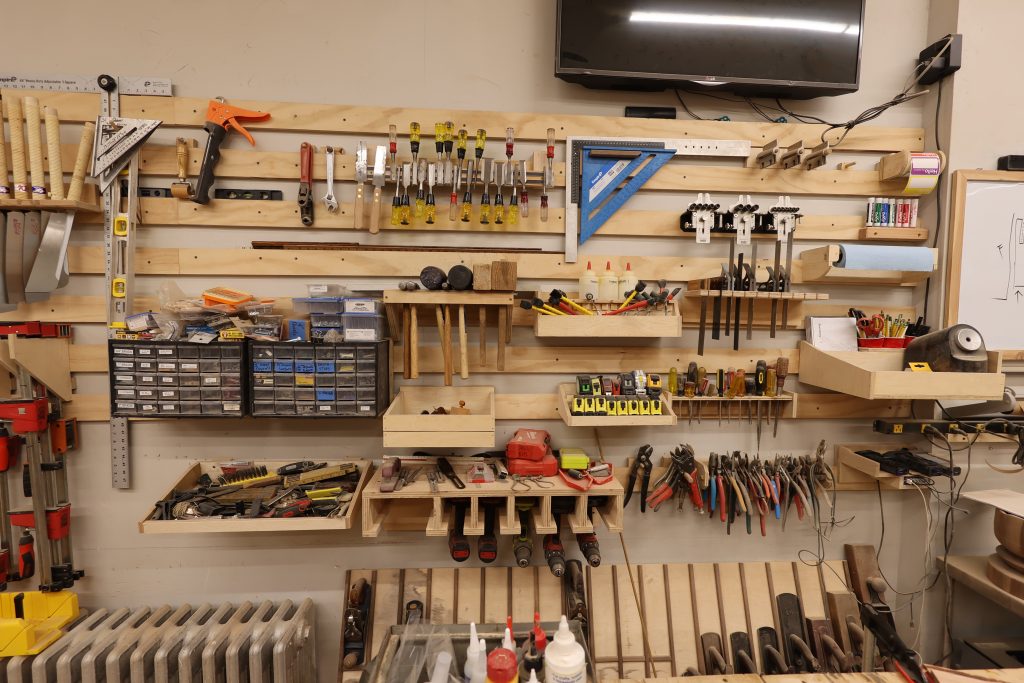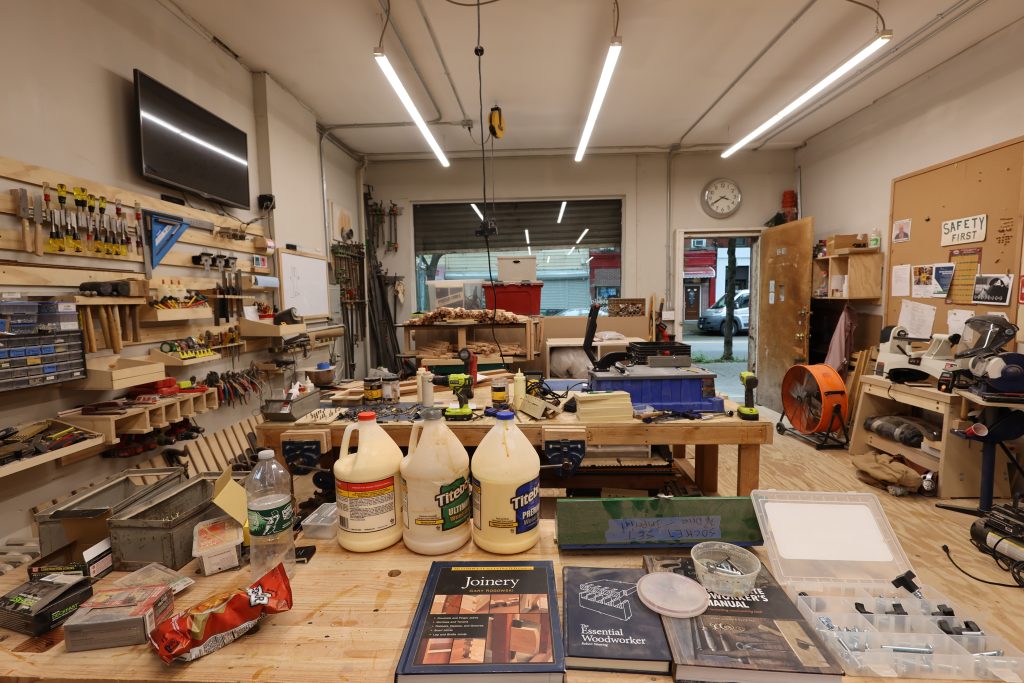
John Bohlmeyer, founder and president of Astoria Woodworkers Collective.
Credit: Stella Raine Chu
Stella Raine Chu
John Bohlmeyer, 36, stands at the table closest to the entranceway of 12-10 Astoria Blvd. Inside, every inch of the shop is utilized—tools, goggles, and lumber line the walls in neat rows, and tables equipped with intimidating saws sit patiently, waiting to be used.
This isn’t just any ordinary shop—it’s the home of the Astoria Woodworkers Collective, a non-profit woodworking organization run entirely by volunteers. The collective was born in the late summer of 2020, when Bohlmeyer, inspired by his time at the Kansas City Woodworkers’ Guild, reached out to Astorians to gauge interest in starting a woodworking group. Bohlmeyer and his wife, Cat Bradley, founded the group of woodworking enthusiasts, with about a dozen consistent members showing up every month. With no physical space, Bohlmeyer, Bradley and the fledgling group would meet
in places like Astoria Park; no woodworking was done, but a community had started to build nevertheless.
But finding and establishing themselves in a physical space had always been part of the collective’s mission plan; by the end of 2022, they held a Kickstarter with a goal of 36,000 dollars. By the end of the funding period, they raised more than 10,000 dollars over their initial goal, totalling at 46,810 dollars. On May 1, 2023, the collective finally opened its doors to their members. For 200 dollars a year plus 13 dollars per hour in the shop, aspiring woodworkers have access to the space, which includes a vast array of tools, machinery, and safety gear.
“We want a place like this to exist in the neighborhood,” Bohlmeyer said. “We don’t pay anybody—the board, our staff, the team that’s supervising up here—everybody’s doing this on a volunteer basis.”
The collective’s staff all have day jobs—Bohlmeyer himself works as an architect for Allied Works, an interdisciplinary studio responsible for projects like the Seattle Art Museum. Whatever free time they have is dedicated to being at the shop.
For the collective, the community response has been overwhelmingly positive. The presence of the shop fills a demand in Queens, where creative spaces are fewer and further in-between in comparison to neighborhoods like Bushwick or Williamsburg. “I feel like artists in Queens always tend to have a chip on their shoulder, because—for whatever reason—Brooklyn is seen as the cooler borough,” Bohlmeyer said.
But for Queens, this is changing. Creatives in neighborhoods long-known for their artistic scenes are being pushed out by expensive rent, leading to these communities shrinking in some and growing in others. As a result, an artistic populace has found itself in Astoria and Long Island City; since 2000, the area has seen a 40 percent increase in creatives (artists, actors, dancers, musicians, and photographers).
But the collective is a place for everyone—not just those in creative industries.

Maggie Chen, a novice woodworker and member of the collective, planing (shaving a piece of lumber to a desired thickness) wood for her coffee table.
Maggie Chen, 33, knew nothing about woodworking when she joined the collective this past January. Chen works in tech and simply wanted a coffee table—but none of the ones on the market quite fit her taste, so she decided to build one herself. When she received an email for the collective’s Something From Nothing class catered to absolute beginners, she didn’t hesitate to sign up. From there, Chen would work on her dream coffee table—from scratch.
“People are here because they want to be,” she said. “It’s not really even about the product, it’s about the process.” As she worked on her coffee table—which isn’t finished yet—she stumbled across other projects alongside other woodworking novices. “We were both beginners, so we were like, ‘You know what? Let’s get lost together.”
For members of the collective, it’s more than just a place to hone their woodworking skills—in fact, the vast majority are complete beginners, just like Chen. It’s exactly this aspect that makes the Astoria Woodworkers Collective such an inclusive and welcoming environment—it’s full of people who are going out of their way to better themselves.
“Sometimes people have more questions than answers,” Justin Elie, 40, said. Elie works as a technical director at The Julliard School, but found a community in the collective when he saw two people walking down the street wearing merchandise from the group.
“When I saw them, I stopped them in the street and I said, ‘What is this? Because I want to know more,” he said. That was more than three years ago—before they opened their physical space. Now, Elie is the Director of Assets and Safety at the collective,
supervising safety training and maintenance of the tools in the shop. He seemed like the perfect fit for such a role; Elie oversees the scenic construction at Julliard and has done so for the last 15 years. In simpler words, he maintains a wood and metal shop at the school.
For Elie, the beginner-friendly environment is exactly what makes the collective feel like a community. Their Something From Nothing class, originally Elie’s idea, illuminated just how true that was. “We had eight people come in and we started to reference simple tool use that we have been familiar with forever,” he said. “You’re going to grab the drill, and drill the hole here,” he recounted telling the class. “Most of the class was like, ‘What is a drill?’”
“It’s fun to be able to help them navigate through the answers and make the choices they want to make,” Elie said. “We have people coming in from so many different walks of life and unique experiences to share.”

Tools line every inch of the wall in the shop.
For Bohlmeyer, the physicality of woodworking is what makes the craft so rewarding. “If I’m spending all day looking at a computer, it’s nice to have an outlet to do something in the physical world and bring it into existence,” Bohlmeyer said. “It’s a different way of
thinking—it affects the way your brain works by actually having to bring things together and figure out how they fit.”
“I’ve always been hands-on, and I’ve been learning how people are not anymore.” Elie said. In a world where work can always be outsourced, building something from scratch is a radical act. Woodworking especially is a craft that takes time, space, and money, precious resources that young people often find themselves lacking. In high schools across America, woodworking classes have slowly disappeared since the 1970s. When schools are faced with budget cuts, college-bound classes take priority, and vocational classes are the first to go.
The ripple effects of slashing these classes from the curriculum may be more detrimental than we think—a decline in young, skilled tradespeople entering the workforce means labor shortages across the country. In pursuit of the home-owning, white-picket-fence-having American Dream, we’re losing the people who build them.
But the collective, whether they know it or not, is changing that. By providing a space and the materials necessary for efficient woodworking, they nurture the craft in a place that is hungry for it.
“I think in any endeavor where you’re doing something different than what currently exists, there’s a certain attitude akin to that—that you’re exploring,” Bohlmeyer said.
While the collective faces challenges—like the limits of their small space—it looks toward its future. With a membership of over 100 people, the group is only growing. They’re working on new equipment, including a recently acquired bandsaw, used to cut lumber into smaller pieces, and a dust collector to make the shop safer and cleaner to work in.
As for Bohlmeyer, he and his wife are expecting their first child. That will mean less time at the collective, but staff at the shop are stepping up and taking on roles for the transition. For the summer, the collective will also be taking on various community projects, like school benches and garden fixtures.
As the weather gets nicer, the shop gets more populated with those looking to work on their projects. While the space can only host about four people actively working at a time, it seems like plenty for their tight-knit community.
Inside the shop, Bohlmeyer, Chen and Elie discuss the best strategies for planing—shaving a piece of lumber down to a desired thickness—wood for Chen’s coffee table. She says it might be done by this weekend, a promise that sounds similar to ones made the past several weekends. Either way, she plans to stay at the collective after its completion—she’s got some projects in mind.
“The fact that you can share this, and we can share this with other people who are exploring woodworking makes it a little easier for everybody to approach it,” Bohlmeyer said. Amidst the sawdust and loud machinery, what’s being built at 12-10 Astoria Blvd is more than just a craft—it’s a community.

The Astoria Woodworkers Collective shop space.


